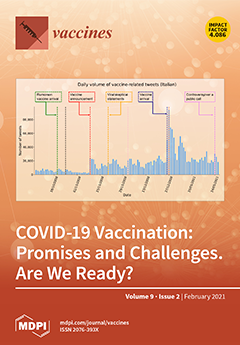The etiologic agent of plague,
Yersinia pestis, is a globally distributed pathogen which poses both a natural and adversarial threat. Due largely to the rapid course and high mortality of pneumonic plague, vaccines are greatly needed. Two-component protein vaccines have been unreliable
[...] Read more.
The etiologic agent of plague,
Yersinia pestis, is a globally distributed pathogen which poses both a natural and adversarial threat. Due largely to the rapid course and high mortality of pneumonic plague, vaccines are greatly needed. Two-component protein vaccines have been unreliable and potentially vulnerable to vaccine resistance. We evaluated the safety and efficacy of eight live
Y. pestis strains derived from virulent strains CO92 or KIM6+ and mutated in one or more virulence-associated gene(s) or cured of plasmid pPst. Stringent, single-dose vaccination allowed down-selection of the two safest and most protective vaccine candidates, CO92 mutants
pgm- pPst- and Δ
yscN. Both completely protected BALB/c mice against subcutaneous and aerosol challenge with
Y. pestis. Strain CD-1 outbred mice were more resistant to bubonic (but not pneumonic) plague than BALB/c mice, but the vaccines elicited partial protection of CD-1 mice against aerosol challenge, while providing full protection against subcutaneous challenge. A Δ
yscN mutant of the nonencapsulated C12 strain was expected to display antigens previously concealed by the capsule. C12 Δ
yscN elicited negligible titers to F1 but comparable antibody levels to whole killed bacteria, as did CO92 Δ
yscN. Although one dose of C12 Δ
yscN was not protective, vaccination with two doses of either CO92 Δ
yscN, or a combination of the Δysc
N mutants of C12 and CO92, protected optimally against lethal bubonic or pneumonic plague. Protection against encapsulated
Y. pestis required inclusion of F1 in the vaccine and was associated with high anti-F1 titers.
Full article






